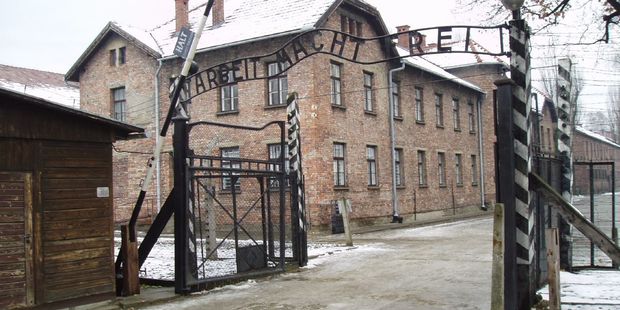Yvonne Engelmann was just 15 when she was rounded up with her family and sent to Auschwitz concentration camp, one of the network of German Nazi extermination camps operated by the Third Reich in Poland in World War II from 1940-1945.
But it was an unlikely miracle that saw her survive to tell the disturbing tale.
After arriving at the camp, Yvonne was immediately sent to the gas chamber. Thanks to some strange twist of fate, it malfunctioned and she was left naked in the chamber overnight before being freed.
By some miracle, the Nazis kept her alive, and she was sent to sort through the clothes of newly arrived Jews to find any gold or valuables they’d hidden.

The infamous German inscription that reads ‘Work Makes Free’ at the main gate of the Auschwitz I extermination camp on November 15, 2014 in Oswiecim, Poland. Photo / AP
Her “job” saw her stationed in between the crematorium (which burnt 24-hours daily) and the gas chambers. She ended up being the sole survivor from her entire family, and made a new life for herself in Australia.
“I was 14 and a half when war broke out,” Yvonne tells news.com.au.
“I wasn’t allowed to go to school, I couldn’t walk on the street, I had to wear the yellow Star of David and couldn’t mix with any non-Jewish people. Friends I’d grown up with now totally ignored me, solely because I was born a Jew.
“My father was taken to the police station many times and we never knew if he would come back. One day he returned and his front teeth had been knocked out. We lived in fear constantly – we had no idea what would happen to us in the next hour, let alone in the next day.”
Born in Czechoslovakia to shopkeeper parents, Yvonne was an only child.
“I had the most wonderful childhood that anyone could wish for, but unfortunately it was short-lived.”

Yvonne Engelman says as a survivor of Auschwitz it is important to perpetuate the memory of those lost and volunteers her time to teach and “tell the world what really happened”. (Photo Source: Sydney Jewish Museum)
In the limbo of uncertainty, things went from bad to worse. Her parents’ shop was taken away and the family was forcibly removed from their home to a cramped Jewish ghetto.
At the approach of her 15th birthday, she and her family were taken from the ghetto – along with hundreds of others – to the railway station where they were piled into dozens of cattle wagons.
“Men, women, children, screaming babies – the journey was too horrific to even describe,” she recalls.
“There was no ventilation, it was hot, an overflowing tin bucket was the only toilet … we were stripped of our humanity.”
(To read more of this article, please follow the link below…)
http://www.nzherald.co.nz/world/news/article.cfm?c_id=2&objectid=11721357
See also related post:





